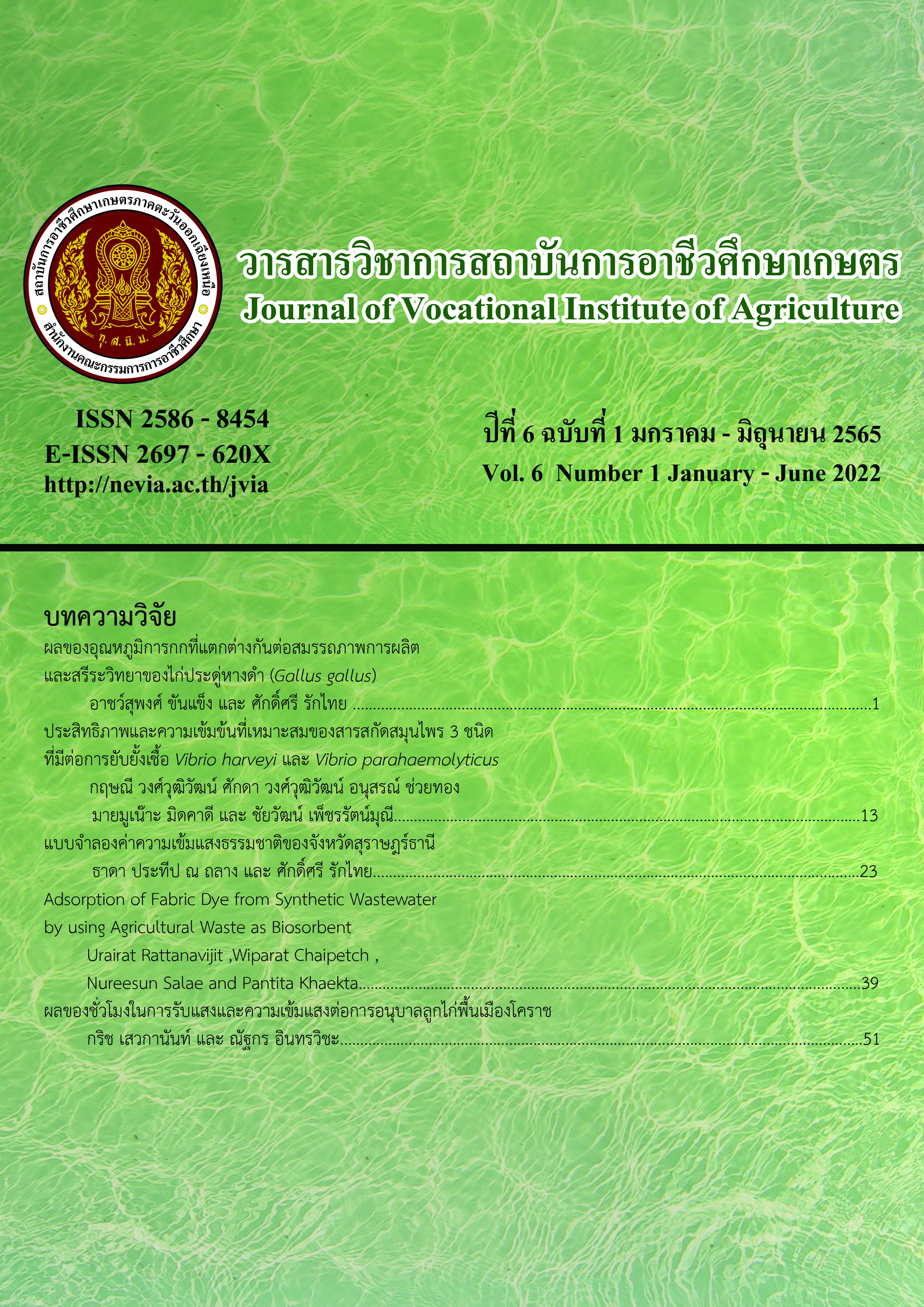แบบจำลองค่าความเข้มแสงธรรมชาติของจังหวัดสุราษฎร์ธานี
Main Article Content
บทคัดย่อ
งานวิจัยนี้มีวัตถุประสงค์เพื่อสร้างแบบจำลองค่าความเข้มแสงธรรมชาติของจังหวัดสุราษฎร์ธานีเพื่อใช้ออกแบบเทคโนโลยีการควบคุมความเข้มแสงธรรมชาติสำหรับประโยขน์ในการเกษตรกรรมหรืองานอื่นๆที่เกี่ยวข้องกับการแสงธรรมชาติ โดยการศึกษาโครงสร้างสิ่งแวดล้อมธรรมชาติที่มีอิทธิพลต่อความเข้มแสงธรรมชาติ จากการสร้างสถานีเก็บข้อมูลทางอุตุนิยมวิทยาแบบเฉพาะพื้นที่และบันทึกข้อมูลตามเวลาจริง (Real time) จำนวน 5 ข้อมูล ได้แก่ ความเข้มแสงธรรมชาติ อุณหภูมิอากาศ ความชื้นสัมพัทธ์ อัตราเร็วลม และ ทิศทางของลม ณ วิทยาลัยเกษตรและเทคโนโลยีสุราษฎร์ธานี ( 8°52'42"N, 98°49'30"E)แล้วนำข้อมูลมาทำการวิเคราะห์สหสัมพันธ์ (Correlation Analysis) และการวิเคราะห์ถดถอยเชิงพหุคูณ (Multiple Regression Analysis) โดยแปลงข้อมูลเป็นลอการิทึมฐานธรรมชาติ (Natural Logarithm Transformation) หรือการวิเคราะห์ความสัมพันธ์ระหว่างตัวแปรกับสิ่งที่เราสนใจโดยอาศัยการแปลงข้อมูลโดยใช้ค่าล็อกธรรมชาติ จึงนำไปสร้างเป็นแบบจำลองค่าความเข้มแสงธรรมชาติในรูปแบบของ Linear Regression with Natural Logarithm Transformation Model หรือ LRNLT-Model จากนั้นทดสอบสมรรถนะของแบบจำลองที่สร้างขึ้นโดยใช้ข้อมูลที่จากสถานีเก็บข้อมูลทางอุตุนิยมวิทยาดังกล่าว พบว่าค่าความเข้มแสงธรรมชาติที่คำนวนได้จากแบบจำลอง(การคำนวณ) มีความสอดคล้องกับค่าที่ได้จากการวัดจริงเป็นอย่างดีโดยมีความแตกต่างของข้อมูลในรูปของค่าที่แสดงถึงความคลาดเคลื่อนระหว่างค่าคำนวณจากแบบจำลองกับค่าจากการวัดจริง (RMSD) เท่ากับ ร้อยละ 8.18 และค่าความเอนเอียงของข้อมูลมีทิศทางไปทางด้านค่าจากการวัดมากกว่าค่าจากการคำนวณ (MBD) เพียงร้อยละ 0.23
Article Details

อนุญาตภายใต้เงื่อนไข Creative Commons Attribution-NonCommercial-NoDerivatives 4.0 International License.
เนื้อหาและข้อมูลในบทความที่ลงตีพิมพ์ใน Journal of Vocational Education in Agriculture ถือเป็นข้อคิดเห็นและความรับผิดชอบของผู้เขียนบทความโดยตรง ซึ่งกองบรรณาธิการวารสารไม่จำเป็นต้องเห็นด้วยหรือร่วมรับผิดชอบใดๆ
บทความ ข้อมูล เนื้อหา ฯลฯ ที่ได้รับการตีพิมพ์ใน Journal of Vocational Education in Agriculture ถือเป็นลิขสิทธิ์ของJournal of Vocational Education in Agriculture หากบุคคลหรือหน่วยงานใดต้องการนำทั้งหมดหรือส่วนหนึ่งส่วนใดไปเผยแพร่ต่อหรือเพื่อกระทำการใดๆ จะต้องได้รับอนุญาตเป็นลายลักษณ์อักษรจาก Journal of Vocational Education in Agriculture ก่อนเท่านั้น
เอกสารอ้างอิง
กัญญกาญจน์ พูนศิริ และกัลยา กองเงิน. (2557). อิทธิพลของความเข้มแสงต่อสรีรวิทยาบางประการและการเปลี่ยนแปลงของโปรตีนในใบข้าวเหนียวดำ. ใน การประชุมวิชาการเสนอผลงานวิจัยระดับบัณฑิตศึกษา ครั้งที่ 15. (น. 882-890). ขอนแก่น: มหาวิทยาลัยขอนแก่น.
Pallardy, S. G. (2008). Physiology of Woody Plants. 3rd Ed. Burlington: Elsevier.
เฉลิมพล แซมเพชร. (2535). สรีรวิทยาการผลิตพืชไร่. กรุงเทพฯ: สำนักพิมพ์โอเดียนสโตร์
อรุณี จันทรสนิท และคณะ. (2547). บทเรียนคอมพิวเตอร์ช่วยสอนบนระบบเครือข่ายอินเตอร์เน็ต การสังเคราะห์ด้วยแสง (Photo Synthesis) เข้าถึงได้จาก http://www.sc.chula.ac.th/courseware/ 2305103/ add_topics/add3/2_photosynthesis.html
นิตยา เกตุแก้ว. (2564). การวิจัยและพัฒนาเทคโนโลยีสิ่งแวดล้อมการผลิตไข่น้ำ. (วิทยานิพนธ์ปริญญาปรัชญาดุษฎีบันฑิต, สถาบันเทคโนโลยีปทุมวัน).
รุ่งรัตน์ วัดตาล. (2548). การศึกษาแบบจำลองและลักษณทางสถิติของความแข้มแสงสว่างธรรมชาติในประเทศไทย. (วิทยานิพนธ์ปริญญามหาบัณฑิต, มหาวิทยาลัยศิลปากร).
นัสรีนา เจ๊ะมะและคณะ. (2559). การสร้างเกรตติงสเปกโตรมิเตอร์โดยใช้แผ่นซีดี (รายงานผลการวิจัย). ยะลา: มหาวิทยาลัยราชภัฏยะลา.
เสริม จันทร์ฉาย และคณะ. (2545). การศึกษาแบบจำลองและลักษณะทางสถิติของรังสีดวงอาทิตย์ในประเทศไทย. (รายงานผลการวิจัย). กรุงเทพฯ: สำนักงานคณะกรรมวิจัยแห่งชาติ.
FAO. (2012). FAOSTAT. from https://www.fao.org/faostat/en/#home.
Corvalan, C. F. & Patz, J. A. (2004). Global warming kills trees, and people. Bulletin of the World Health Organization, 82 (7): 481.
Aggarwal, P. K., & Penning de Vries, F. W. T. (1989). Potential and water-limited wheatt yields in rice based cropping systems in Southeast Asia. Agricultural Systems, 30(1), 49--69.
สำนักงานเกษตรและสหกรณ์จังหวัดสุราษธานี. (2562). ข้อมูลพื้นฐานด้านการเกษตรและสหกรณ์จังหวัดสุราษฎร์ธานี ปี 2561. เข้าถึงได้จาก https://www.opsmoac.go.th/suratthani-dwl-files-411591791865
จริญญา ฤทธิรัมย์ และอารักษ์ ธีรอำพน. (2562). ผลของความเข้มแสงต่อการเจริญเติบโตและผลผลิตของผักกาดหอมในระบบแพลนท์แฟคทอรี่. แก่นเกษตร, 47(6), 1243-1250.
อรัญ ประกอบสัญท์ และคณะ. (2559). การพัฒนาระบบควบคุมการส่องสว่างสำหรับการปลูกพืชด้วยเครือข่ายเซ็นเซอร์ไร้สาย. วารสารวิทยาการและเทคโนโลยีสารสนเทศ, 6(2), 1-8.
เอกพันธ์ มาเลิศ และเอกสิทธิ์ โฆสิตสกุลชัย. (2562). การประเมินผลของความแปรปรวนภูมิอากาศต่อศักยภาพผลผลิตของข้าวนาสวนในจังหวัดชัยนาทด้วยแบบจำลอง DSSAT-CERES. ใน 12th THAICID NATIONAL SYMPOSIUM. (น.73-86). นนทบุรี: กรมชลประทาน.
ณรัฐ รุจิรัตน (2557). ความรู้ความเข้าใจด้านมาตรวิทยาและระบบคุณภาพ เข้าถึงได้จาก https://www.nimt.or.th/training/files/CognitiveMetrologyAndQualitySystems.pdf.
ตรีนุช เอลลิส และคณะ. (2562). แบบจำลองสำหรับคำนวณค่ารังสีรวมของดวงอาทิตย์จากข้อมูลอุตุนิยมวิทยาสำหรับจังหวัดเพชรบูรณ์. วารสารมหาวิทยาลัยนราธิวาสราชนครินทร์. 11(2). 132-141.
เสริม จันทร์ฉาย. (2560). รังสีอาทิตย์. นครปฐม: บริษัท เพชรเกษมพริ้นติ้ง กรุ๊ป จำกัด.
Maximintegrated. (2001). RS-485 (EIA/TIA-485) Differential Data Transmission System Basics. Retrived 1 November 2021. From https://www.maximintegrated.com/.

